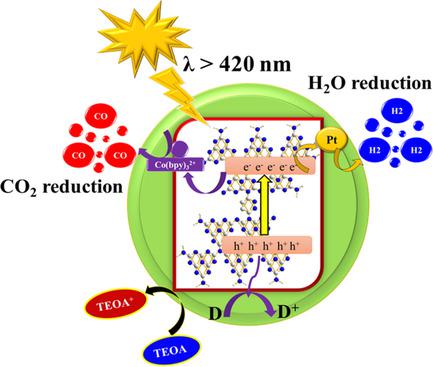当前位置:
X-MOL 学术
›
Energy Technol.
›
论文详情
Our official English website, www.x-mol.net, welcomes your
feedback! (Note: you will need to create a separate account there.)
Organic Conjugation of Polymeric Carbon Nitride for Improved Photocatalytic CO2 Conversion and H2 Fixation
Energy Technology ( IF 3.6 ) Pub Date : 2021-07-14 , DOI: 10.1002/ente.202100091 Asif Hayat 1, 2 , T.A. Taha 3, 4 , Asma M. Alenad 5 , Lin yingjin 2 , Ashiq Hayat 6 , Muhammad khan 7 , Ata Ur rehman 8 , Sunil Kumar Baburao Mane 9 , Wasim Ullah Khan 10
Energy Technology ( IF 3.6 ) Pub Date : 2021-07-14 , DOI: 10.1002/ente.202100091 Asif Hayat 1, 2 , T.A. Taha 3, 4 , Asma M. Alenad 5 , Lin yingjin 2 , Ashiq Hayat 6 , Muhammad khan 7 , Ata Ur rehman 8 , Sunil Kumar Baburao Mane 9 , Wasim Ullah Khan 10
Affiliation

|
The systematic alteration of a carbon nitride unit (CNU) for visible light photocatalytic water splitting is a promising research subject owing to the increasingly serious energy and environmental complications. Herein, the conjugated monomer 3,6-dibromopyridazine (DBP) is integrated within polymeric carbon nitride (PCN named as CNU = carbon nitride containing urea precursor) via thermal condensation, which is designated as CNU-DBP. These samples are used for the first time in the photocatalytic conversion of CO2 reduction and hydrogen (H2) evolution through water splitting. Such integration intimidates the electron density, promoting charge transfer separation and elevating the photocatalytic activity of CNU under visible light illumination. The superior sample such as CNU-DBP9.0 after 4 h of photooxidation generates 65.7 μmol of CO and 17.3 μmol of H2 of the reaction system, emphasizing the highest photocatalytic activity. The H2 evolution rate (HER) for pristine CNU is found as 11.9 μmol h−1, whereas for CNU-DBP9.0 it is estimated at 178.2 μmol h−1 with 15 times greater activity. This process predicts a significant diversion in the specific area, bandgap, and chemical composition and promotes the efficient separation of photogenerated charge carriers from the ground state to the excited state of CNU, thereby considering it a best candidate for the photoreduction of CO2 source and water splitting into H2.
中文翻译:

聚合氮化碳的有机共轭用于改进光催化 CO2 转化和 H2 固定
由于日益严重的能源和环境并发症,用于可见光光催化分解水的氮化碳单元(CNU)的系统改造是一个很有前途的研究课题。在本文中,共轭单体 3,6-二溴哒嗪 (DBP) 通过热缩合整合到聚合氮化碳 (PCN 命名为 CNU = 含尿素前体的氮化碳) 中,称为 CNU-DBP。这些样品首次用于 CO 2还原和通过水分解释放氢气 (H 2 )的光催化转化。这种集成抑制了电子密度,促进了电荷转移分离并提高了 CNU 在可见光照射下的光催化活性。CNU-DBP等优质样品9.0光氧化 4 小时后生成 65.7 μmol CO 和 17.3 μmol H 2反应体系,强调最高的光催化活性。原始CNU的H 2演化速率(HER) 被发现为11.9 μmol h -1,而对于CNU-DBP 9.0,估计为178.2 μmol h -1,活性高15 倍。该过程预测了特定区域、带隙和化学成分的显着转移,并促进了光生载流子从基态到 CNU 激发态的有效分离,从而将其视为光还原 CO 2源和水分解成H 2。
更新日期:2021-07-14
中文翻译:

聚合氮化碳的有机共轭用于改进光催化 CO2 转化和 H2 固定
由于日益严重的能源和环境并发症,用于可见光光催化分解水的氮化碳单元(CNU)的系统改造是一个很有前途的研究课题。在本文中,共轭单体 3,6-二溴哒嗪 (DBP) 通过热缩合整合到聚合氮化碳 (PCN 命名为 CNU = 含尿素前体的氮化碳) 中,称为 CNU-DBP。这些样品首次用于 CO 2还原和通过水分解释放氢气 (H 2 )的光催化转化。这种集成抑制了电子密度,促进了电荷转移分离并提高了 CNU 在可见光照射下的光催化活性。CNU-DBP等优质样品9.0光氧化 4 小时后生成 65.7 μmol CO 和 17.3 μmol H 2反应体系,强调最高的光催化活性。原始CNU的H 2演化速率(HER) 被发现为11.9 μmol h -1,而对于CNU-DBP 9.0,估计为178.2 μmol h -1,活性高15 倍。该过程预测了特定区域、带隙和化学成分的显着转移,并促进了光生载流子从基态到 CNU 激发态的有效分离,从而将其视为光还原 CO 2源和水分解成H 2。











































 京公网安备 11010802027423号
京公网安备 11010802027423号